Knockdown of SOX2OT inhibits the malignant biological behaviors of glioblastoma stem cells via up-regulating the expression of miR-194-5p and miR-122
- PMID: 29132362
- PMCID: PMC5683208
- DOI: 10.1186/s12943-017-0737-1
Knockdown of SOX2OT inhibits the malignant biological behaviors of glioblastoma stem cells via up-regulating the expression of miR-194-5p and miR-122
Erratum in
-
Correction: Knockdown of SOX2OT inhibits the malignant biological behaviors of glioblastoma stem cells via up-regulating the expression of miR-194-5p and miR-122.Mol Cancer. 2022 Oct 22;21(1):202. doi: 10.1186/s12943-022-01673-y. Mol Cancer. 2022. PMID: 36273152 Free PMC article. No abstract available.
Abstract
Background: Accumulating evidence has highlighted the potential role of long non-coding RNAs (lncRNAs) in the biological behaviors of glioblastoma stem cells (GSCs). Here, we elucidated the function and possible molecular mechanisms of the effect of lncRNA-SOX2OT on the biological behaviors of GSCs.
Results: Real-time PCR demonstrated that SOX2OT expression was up-regulated in glioma tissues and GSCs. Knockdown of SOX2OT inhibited the proliferation, migration and invasion of GSCs, and promoted GSCs apoptosis. MiR-194-5p and miR-122 were down-regulated in human glioma tissues and GSCs, and miR-194-5p and miR-122 respectively exerted tumor-suppressive functions by inhibiting the proliferation, migration and invasion of GSCs, while promoting GSCs apoptosis. Knockdown of SOX2OT significantly increased the expression of miR-194-5p and miR-122 in GSCs. Dual-luciferase reporter assay revealed that SOX2OT bound to both miR-194-5p and miR-122. SOX3 and TDGF-1 were up-regulated in human glioma tissues and GSCs. Knockdown of SOX3 inhibited the proliferation, migration and invasion of GSCs, promoted GSCs apoptosis, and decreased TDGF-1 mRNA and protein expression through direct binding to the TDGF-1 promoter. Over-expression of miR-194-5p and miR-122 decreased the mRNA and protein expression of SOX3 by targeting its 3'UTR. Knockdown of TDGF-1 inhibited the proliferation, migration and invasion of GSCs, promoted GSCs apoptosis, and inhibited the JAK/STAT signaling pathway. Furthermore, SOX3 knockdown also inhibited the SOX2OT expression through direct binding to the SOX2OT promoter and formed a positive feedback loop.
Conclusion: This study is the first to demonstrate that the SOX2OT-miR-194-5p/miR-122-SOX3-TDGF-1 pathway forms a positive feedback loop and regulates the biological behaviors of GSCs, and these findings might provide a novel strategy for glioma treatment.
Keywords: Glioma; SOX2OT; SOX3; TDGF-1; miR-122; miR-194-5p.
Conflict of interest statement
Competing interests
The authors declare that they have no competing interests.
Publisher’s Note
Springer Nature remains neutral with regard to jurisdictional claims in published maps and institutional affiliations.
Figures
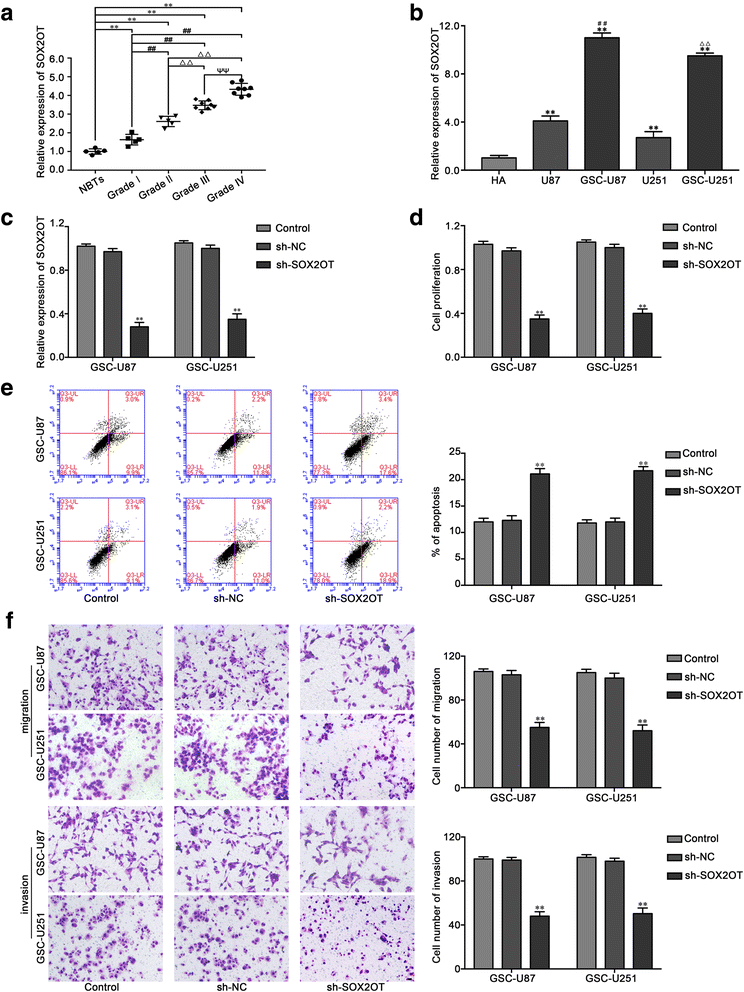
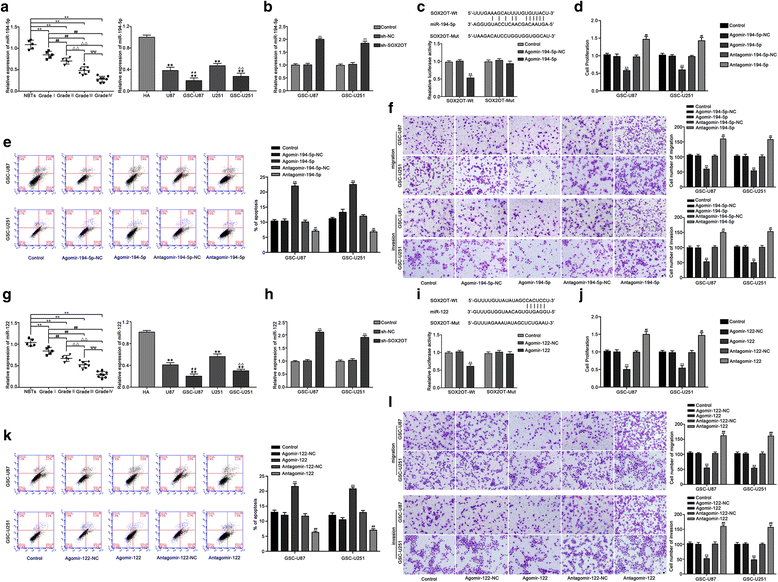

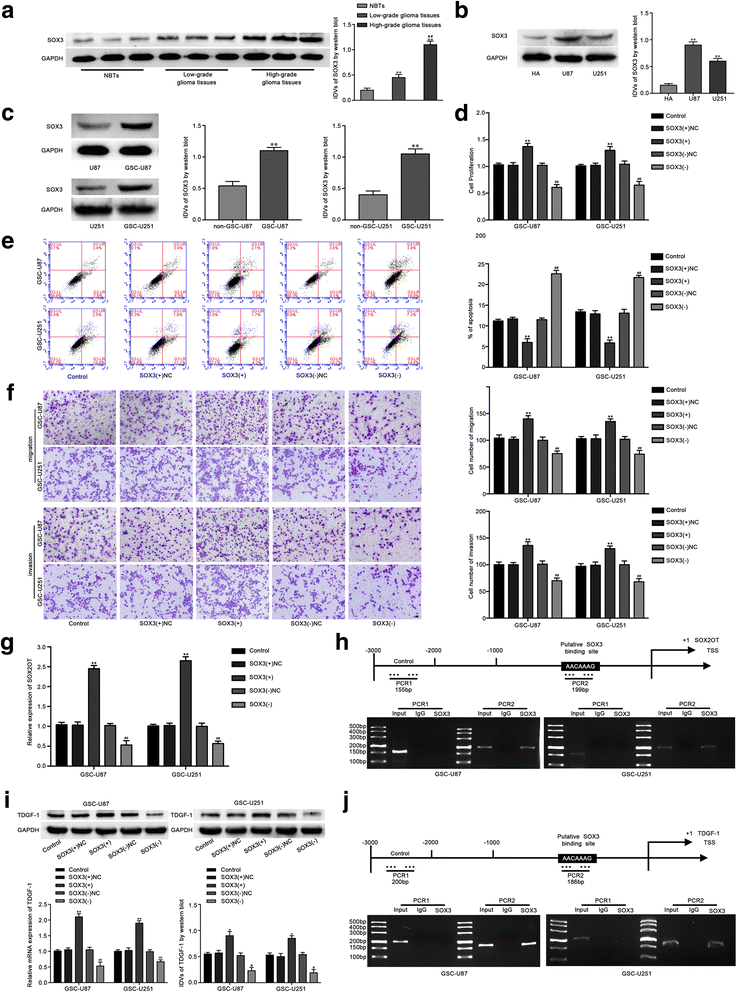
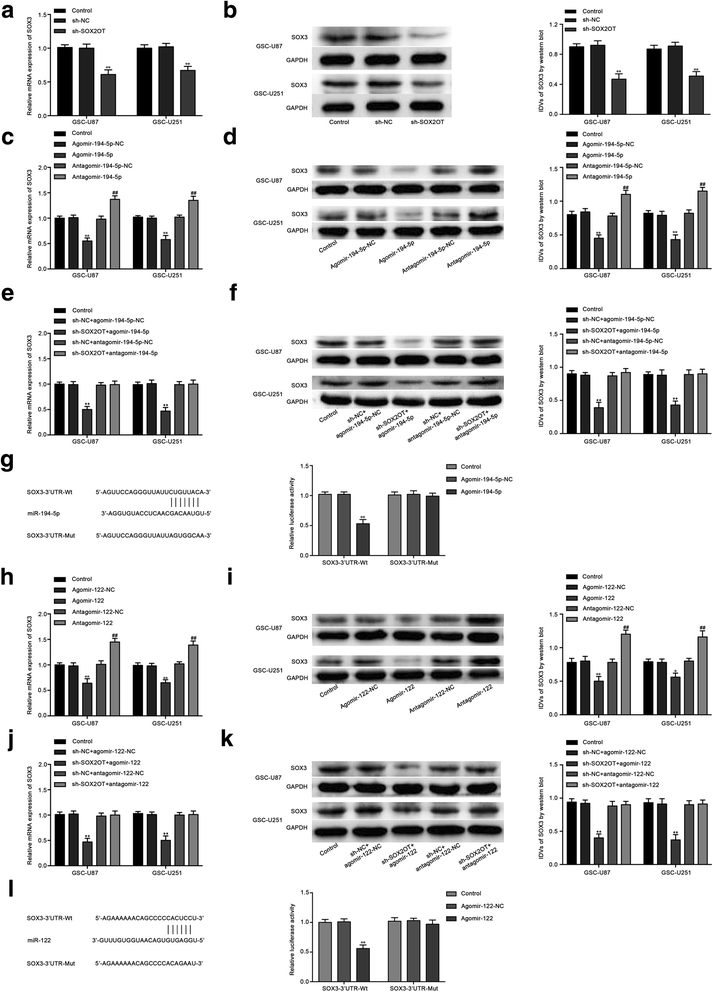
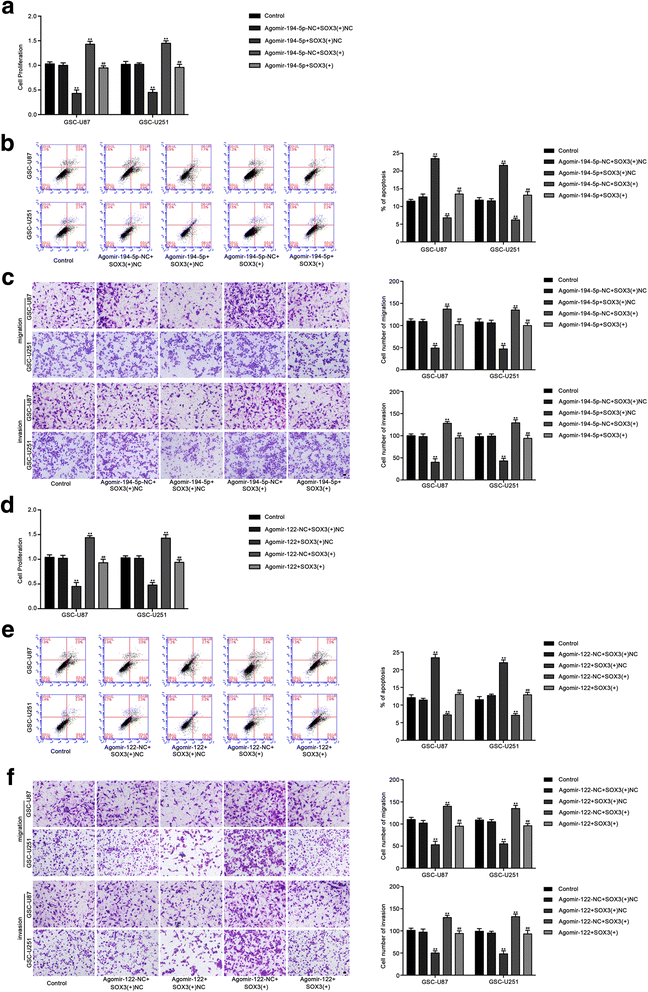
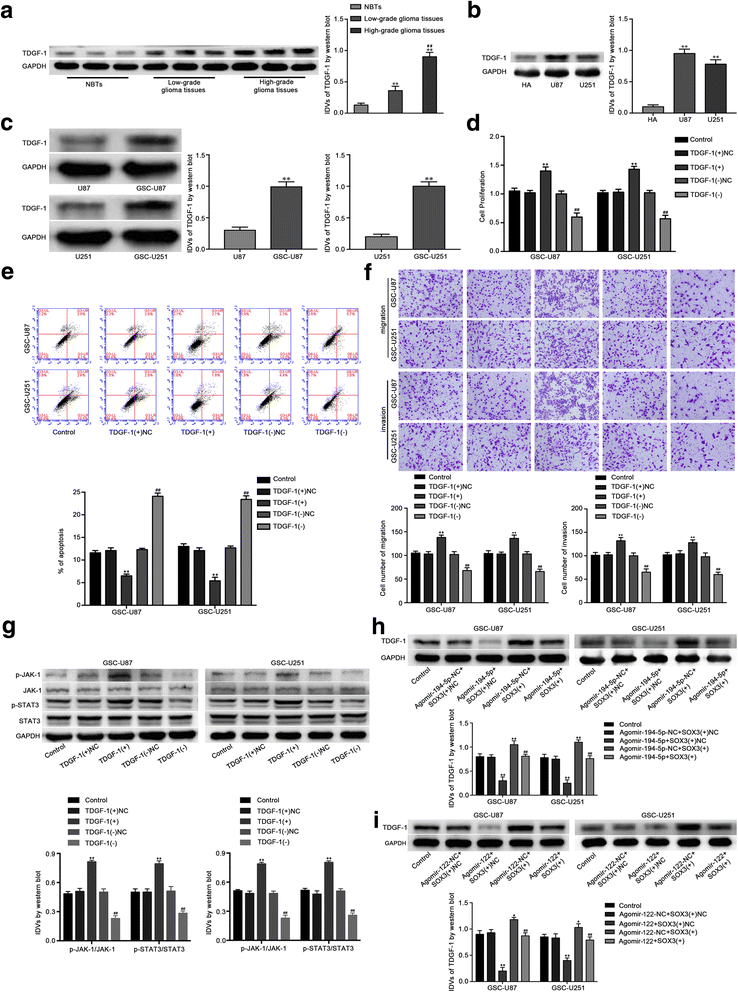
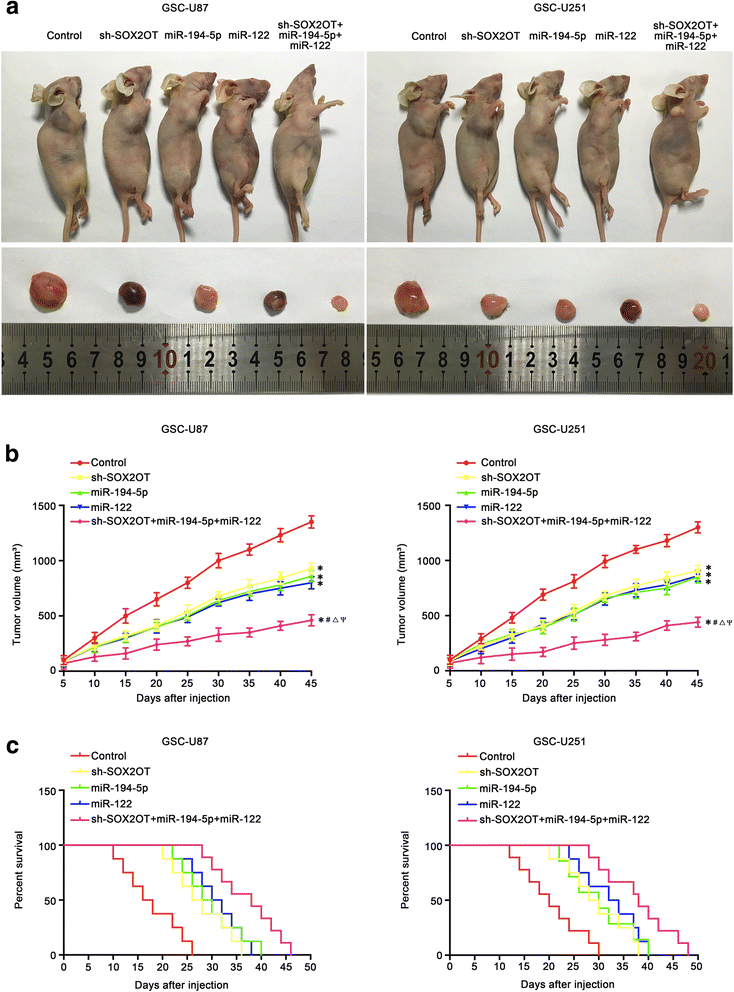
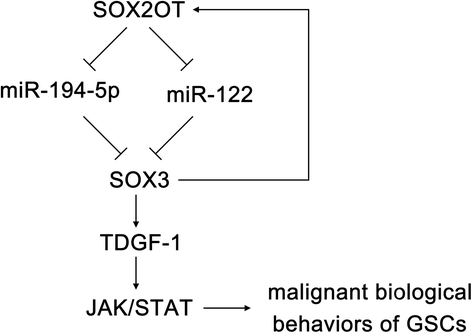
Similar articles
-
NR2C2-uORF targeting UCA1-miR-627-5p-NR2C2 feedback loop to regulate the malignant behaviors of glioma cells.Cell Death Dis. 2018 Dec 5;9(12):1165. doi: 10.1038/s41419-018-1149-x. Cell Death Dis. 2018. PMID: 30518750 Free PMC article.
-
Knockdown of long non-coding RNA XIST exerts tumor-suppressive functions in human glioblastoma stem cells by up-regulating miR-152.Cancer Lett. 2015 Apr 1;359(1):75-86. doi: 10.1016/j.canlet.2014.12.051. Epub 2015 Jan 8. Cancer Lett. 2015. PMID: 25578780
-
Linc00152 promotes malignant progression of glioma stem cells by regulating miR-103a-3p/FEZF1/CDC25A pathway.Mol Cancer. 2017 Jun 26;16(1):110. doi: 10.1186/s12943-017-0677-9. Mol Cancer. 2017. Retraction in: Mol Cancer. 2022 Sep 29;21(1):188. doi: 10.1186/s12943-022-01660-3. PMID: 28651608 Free PMC article. Retracted.
-
Molecular Mechanisms and Strategies for Inducing Neuronal Differentiation in Glioblastoma Cells.Cell Reprogram. 2025 Feb;27(1):24-32. doi: 10.1089/cell.2024.0087. Epub 2025 Jan 30. Cell Reprogram. 2025. PMID: 39880036 Review.
-
Glioblastoma Stem Cells: Driving Resilience through Chaos.Trends Cancer. 2020 Mar;6(3):223-235. doi: 10.1016/j.trecan.2020.01.009. Epub 2020 Feb 3. Trends Cancer. 2020. PMID: 32101725 Free PMC article. Review.
Cited by
-
Glioma glycolipid metabolism: MSI2-SNORD12B-FIP1L1-ZBTB4 feedback loop as a potential treatment target.Clin Transl Med. 2021 May;11(5):e411. doi: 10.1002/ctm2.411. Clin Transl Med. 2021. PMID: 34047477 Free PMC article.
-
A novel lncRNA SOX2OT promotes the malignancy of human colorectal cancer by interacting with miR-194-5p/SOX5 axis.Cell Death Dis. 2021 May 15;12(5):499. doi: 10.1038/s41419-021-03756-y. Cell Death Dis. 2021. PMID: 33993197 Free PMC article.
-
Microarray analysis reveals long non‑coding RNA SOX2OT as a novel candidate regulator in diabetic nephropathy.Mol Med Rep. 2018 Dec;18(6):5058-5068. doi: 10.3892/mmr.2018.9534. Epub 2018 Oct 4. Mol Med Rep. 2018. PMID: 30320339 Free PMC article.
-
Upregulation of microRNA‑194‑5p inhibits hypopharyngeal carcinoma cell proliferation, migration and invasion by targeting SMURF1 via the mTOR signaling pathway.Int J Oncol. 2019 Apr;54(4):1245-1255. doi: 10.3892/ijo.2019.4711. Epub 2019 Feb 4. Int J Oncol. 2019. PMID: 30720112 Free PMC article.
-
Transcription factor AP-4 (TFAP4)-upstream ORF coding 66 aa inhibits the malignant behaviors of glioma cells by suppressing the TFAP4/long noncoding RNA 00520/microRNA-520f-3p feedback loop.Cancer Sci. 2020 Mar;111(3):891-906. doi: 10.1111/cas.14308. Epub 2020 Feb 11. Cancer Sci. 2020. PMID: 31943575 Free PMC article.
References
MeSH terms
Substances
Grants and funding
LinkOut - more resources
Full Text Sources
Other Literature Sources
Medical

